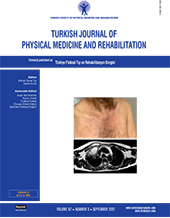Assessment of lower limb peripheral nerves with ultrasound in patients with traumatic amputation
Patients and methods: This cross-sectional study included a total of 33 male patients (mean age: 36.6±8.7 years; range, 21 to 48 years) who had LLA due to traumatic injury between May 2019 and April 2020. Amputation and prosthesis use and functional K level of activity were recorded. Ultrasound examinations were performed to measure the cross-sectional areas (CSAs) of the SN, CPN, and TN bilaterally at the same levels. The values from the normal sides were accepted as controls.
Results: The CSA values were greater on the amputated sides than the non-amputated sides for SN (p=0.001), TN (p=0.001), and CPN (p=0.015), regardless of the activity level. The amputated side SN (p=0.001), TN (p=0.001), and CPN (p=0.016) were thicker in patients with level of K4 activity than the non-amputated side. For the patients with K3 activity level, larger TN CSA values were determined on the amputated side, compared to those at the K4 level (p=0.035). The SN was found to be greater in patients using microprocessor-controlled knee prosthesis (p=0.032) and TN was larger in hypobaric sealing membrane users on the amputated sides (p=0.041).
Conclusion: The SN, CPN, and TN were found to be larger in all patients on the amputated sides and in patients with K4 activity level. Based on these findings, the K3 activity level and the use of hypobaric sealing membrane seems to affect the CSA values of TN. Additionally, the use of microprocessor knee prosthesis affects the CSA values of SN. We believe that these results may be essential for the analysis or prediction of lower extremity nerve involvement according to the K activity level and the use of prosthesis in patients with traumatic LLA.
Keywords : Activity level, amputation, lower limb, peripheral nerve, ultrasound

















